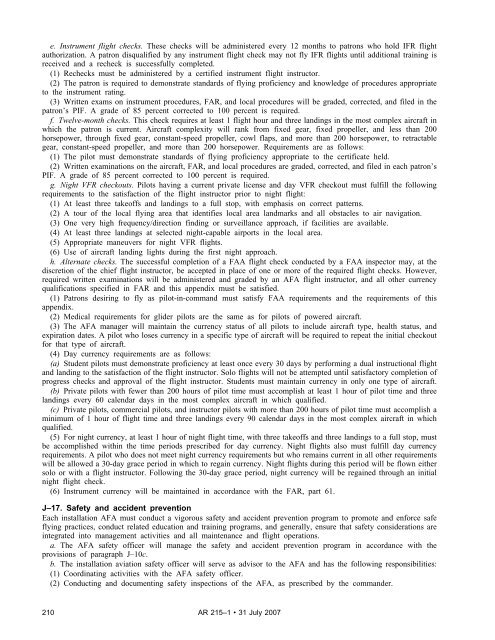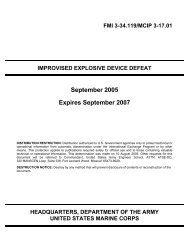AR 215-1 - Soldier Support Institute - U.S. Army
AR 215-1 - Soldier Support Institute - U.S. Army
AR 215-1 - Soldier Support Institute - U.S. Army
Create successful ePaper yourself
Turn your PDF publications into a flip-book with our unique Google optimized e-Paper software.
e. Instrument flight checks. These checks will be administered every 12 months to patrons who hold IFR flight<br />
authorization. A patron disqualified by any instrument flight check may not fly IFR flights until additional training is<br />
received and a recheck is successfully completed.<br />
(1) Rechecks must be administered by a certified instrument flight instructor.<br />
(2) The patron is required to demonstrate standards of flying proficiency and knowledge of procedures appropriate<br />
to the instrument rating.<br />
(3) Written exams on instrument procedures, F<strong>AR</strong>, and local procedures will be graded, corrected, and filed in the<br />
patron’s PIF. A grade of 85 percent corrected to 100 percent is required.<br />
f. Twelve-month checks. This check requires at least 1 flight hour and three landings in the most complex aircraft in<br />
which the patron is current. Aircraft complexity will rank from fixed gear, fixed propeller, and less than 200<br />
horsepower, through fixed gear, constant-speed propeller, cowl flaps, and more than 200 horsepower, to retractable<br />
gear, constant-speed propeller, and more than 200 horsepower. Requirements are as follows:<br />
(1) The pilot must demonstrate standards of flying proficiency appropriate to the certificate held.<br />
(2) Written examinations on the aircraft, F<strong>AR</strong>, and local procedures are graded, corrected, and filed in each patron’s<br />
PIF. A grade of 85 percent corrected to 100 percent is required.<br />
g. Night VFR checkouts. Pilots having a current private license and day VFR checkout must fulfill the following<br />
requirements to the satisfaction of the flight instructor prior to night flight:<br />
(1) At least three takeoffs and landings to a full stop, with emphasis on correct patterns.<br />
(2) A tour of the local flying area that identifies local area landmarks and all obstacles to air navigation.<br />
(3) One very high frequency/direction finding or surveillance approach, if facilities are available.<br />
(4) At least three landings at selected night-capable airports in the local area.<br />
(5) Appropriate maneuvers for night VFR flights.<br />
(6) Use of aircraft landing lights during the first night approach.<br />
h. Alternate checks. The successful completion of a FAA flight check conducted by a FAA inspector may, at the<br />
discretion of the chief flight instructor, be accepted in place of one or more of the required flight checks. However,<br />
required written examinations will be administered and graded by an AFA flight instructor, and all other currency<br />
qualifications specified in F<strong>AR</strong> and this appendix must be satisfied.<br />
(1) Patrons desiring to fly as pilot-in-command must satisfy FAA requirements and the requirements of this<br />
appendix.<br />
(2) Medical requirements for glider pilots are the same as for pilots of powered aircraft.<br />
(3) The AFA manager will maintain the currency status of all pilots to include aircraft type, health status, and<br />
expiration dates. A pilot who loses currency in a specific type of aircraft will be required to repeat the initial checkout<br />
for that type of aircraft.<br />
(4) Day currency requirements are as follows:<br />
(a) Student pilots must demonstrate proficiency at least once every 30 days by performing a dual instructional flight<br />
and landing to the satisfaction of the flight instructor. Solo flights will not be attempted until satisfactory completion of<br />
progress checks and approval of the flight instructor. Students must maintain currency in only one type of aircraft.<br />
(b) Private pilots with fewer than 200 hours of pilot time must accomplish at least 1 hour of pilot time and three<br />
landings every 60 calendar days in the most complex aircraft in which qualified.<br />
(c) Private pilots, commercial pilots, and instructor pilots with more than 200 hours of pilot time must accomplish a<br />
minimum of 1 hour of flight time and three landings every 90 calendar days in the most complex aircraft in which<br />
qualified.<br />
(5) For night currency, at least 1 hour of night flight time, with three takeoffs and three landings to a full stop, must<br />
be accomplished within the time periods prescribed for day currency. Night flights also must fulfill day currency<br />
requirements. A pilot who does not meet night currency requirements but who remains current in all other requirements<br />
will be allowed a 30-day grace period in which to regain currency. Night flights during this period will be flown either<br />
solo or with a flight instructor. Following the 30-day grace period, night currency will be regained through an initial<br />
night flight check.<br />
(6) Instrument currency will be maintained in accordance with the F<strong>AR</strong>, part 61.<br />
J–17. Safety and accident prevention<br />
Each installation AFA must conduct a vigorous safety and accident prevention program to promote and enforce safe<br />
flying practices, conduct related education and training programs, and generally, ensure that safety considerations are<br />
integrated into management activities and all maintenance and flight operations.<br />
a. The AFA safety officer will manage the safety and accident prevention program in accordance with the<br />
provisions of paragraph J–10c.<br />
b. The installation aviation safety officer will serve as advisor to the AFA and has the following responsibilities:<br />
(1) Coordinating activities with the AFA safety officer.<br />
(2) Conducting and documenting safety inspections of the AFA, as prescribed by the commander.<br />
210 <strong>AR</strong> <strong>215</strong>–1 • 31 July 2007

















